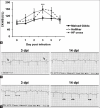Hematological and serum biochemical profile in cattle experimentally infected with foot-and-mouth disease virus
- PMID: 32367945
- PMCID: PMC7183469
- DOI: 10.14202/vetworld.2020.426-432
Hematological and serum biochemical profile in cattle experimentally infected with foot-and-mouth disease virus
Abstract
Background and aim: Foot-and-mouth disease (FMD) is an acute viral infection affecting cloven-hoofed animals causing vesicular erosions in the oral cavity and interdigital space. The present study was undertaken to ascertain the time-dependent changes in clinical, hematological, and biochemical profiles in different breeds of cattle following experimental infection.
Materials and methods: The animals were inoculated with 1.0×104 50% bovine tongue infectious dose (BTID50) by intradermolingual route. Clinical signs were observed, and blood/serum samples were collected at different time intervals.
Results: The white blood cell count declined sharply on days 7-13 and recovered on day 14 post-FMD infection. Biochemical analysis of serum markers for vital organ profile revealed no marked damage. However, a significant increase in blood urea nitrogen (BUN) value indicated pre-renal azotemia. Transient hyperthyroidism was indicated by the rise in T3 and T4 that can be correlated with a decrease in triglyceride and total cholesterol levels. In the cardiac damage assessment study, a distinct breed difference was observed wherein Malnad Gidda calves showed no cardiac damage.
Conclusion: Except thyroid profile, BUN, and creatine kinase-myocardial band, all other serum biochemical parameters showed no significant abnormalities, whereas lymphopenia is the only hematological change and it is suggested that effective ameliorative measures should be targeted mainly on the feed/water intake, thyroid gland, and the level of lymphocytes.
Keywords: biochemical profile; experimentally infected indigenous and crossbred calves; foot-and-mouth disease; hematological profile.
Copyright: © Saravanan, et al.
Figures






References
-
- Rich K.M, Winter-Nelson A.E. An integrated epidemiological-economic analysis of foot and mouth disease:Applications to the Southern Cone of South America. Am. J. Agric. Econ. 2007;89(3):682–697.
-
- Bandyopadhyay S.K. AICRP Report on Foot and Mouth Disease. Indian Veterinary Research Institute, Mukteshwar, India. 2004
-
- Venkataramanan R, Hemadri D, Bandyopadhyay S.K, Taneja V.K. Foot-and-mouth Disease in India:Present Status. Paper Presented at a Workshop on Global Roadmap for Improving the Tools to Control Foot-and-mouth Disease in Endemic Settings, 29 Nov-1 Dec 2006, Agra. 2006
-
- Kitching R.P. Identification of foot and mouth disease virus carrier and subclinically infected animals and differentiation from vaccinated animals. Rev. Sci. Tech. 2002;21(3):531–535. - PubMed
-
- Rowlands G.J, Payne J.M, Dew S.M, Manston R. A potential use of metabolic profiles in the selection of superior cattle. Vet. Rec. 1973;93(2):48–49. - PubMed
LinkOut - more resources
Full Text Sources
